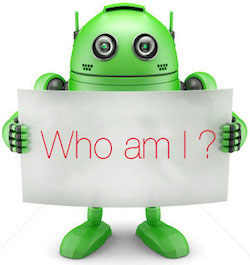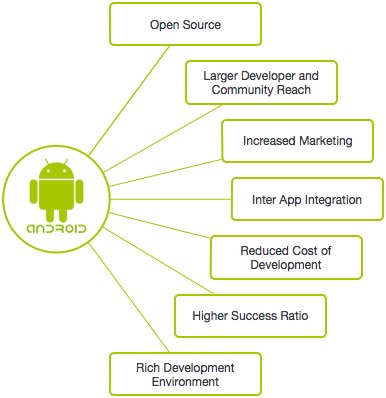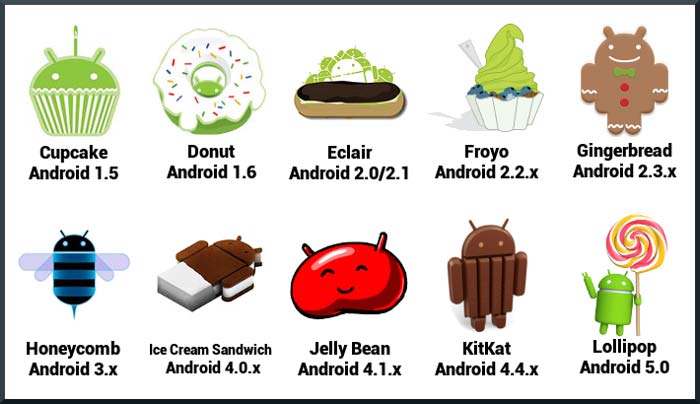Android Overview
What is Android?
 Android is an open source, Linux-based operating system for mobile devices such as smart phones and tablets. Android by Google and other companies led Open Handset Alliance developed.
Android is an open source, Linux-based operating system for mobile devices such as smart phones and tablets. Android by Google and other companies led Open Handset Alliance developed. Android provides a unified approach to application development, which means that developers need only to Android development, so that their applications can run on different mobile devices running Android.
Google released the first beta version of the Android software development kit (SDK) in 2007, the first commercial version of Android 1.0, is released in September 2008.
June 27, 2012, at the Google I / O conference, Google announced the release of the Android version 4.1 Jelly Bean. Jelly Bean is an incremental update in functionality and performance, the main purpose is to improve the user interface,
Android source code is based on free and open source software licenses. Most of the code Google released under the Apache License Version 2.0, Linux kernel changes the GNU General Public License version 2.
Android Development Advantages
- Open Source
- Many developers and stronger communities
- Growing market
- International App Integration
- Low development costs
- Higher probability of success
- Rich development environment

Characteristics of Android
Android is a powerful and Apple 4GS competing operating system functions, and supports some great features. Some features include the following:
| characteristic | description |
|---|---|
| Beautiful UI | Basic screen Android operating system provides a beautiful and intuitive user interface. |
| Connectivity | GSM / EDGE, IDEN, CDMA, EV-DO, UMTS, Bluetooth, Wi-Fi, LTE, NFC and WiMAX. |
| storage | Lightweight SQLite relational database for data storage |
| media support | H.263, H.264, MPEG-4 SP, AMR, AMR-WB, AAC, HE-AAC, AAC 5.1, MP3, MIDI, Ogg Vorbis, WAV, JPEG, PNG, GIF, and BMP |
| news | SMS and MMS |
| Web Browser | Based on the open source WebKit layout engine, coupled with support for HTML5 and CSS3 Chrome's V8 JavaScript engine. |
| multi touch | Android native support for multi-touch, from the initial handheld devices began with, such as HTC Hero. |
| Multitasking | Users can jump from one task to another, and the same time can run a variety of applications. |
| Adjustable widgets | Widgets are resizable, so users can expand more content or shrink to save space. |
| multi-language | It supports one-way and multi-directional text. |
| GCM | Google Cloud Messaging (GCM) is a service that allows developers to send a short message data to the user's Android device without the need for proprietary synchronization solution. |
| Wi-Fi Direct | A connector for high-bandwidth peer network discovery and pairing the direct application of technology. |
| Android Beam | A popular NFC-based technology that enables users to instantly share, simply by touching two NFC-enabled phones together. |
Android Applications
Android applications typically use the Android software development kit, using the Java language to develop.
Once the development is completed, Android applications can be easily packaged and sold on Google Play and the Amazon app store such as.
Android millions of mobile devices in more than 190 countries around the world. This is the largest installed base of any mobile platform for rapid growth. Around the world every day more than 1 million new Android devices are activated.
Writing The purpose of this tutorial is to teach you how to develop and package the Android application. We'll Android application programming environments set the start and in-depth Android application development in all aspects.
Category Android application
There are many Android applications on the market. The main categories are:

Android History
Android code name is now routed from A L, respectively Aestro, Blender, Cupcake, Donut, Eclair, Froyo, Gingerbread, Honeycomb, Ice Cream Sandwitch, Jelly Bean, KitKat and Lollipop. Let us in order to understand the history of Android.
- Cupcake (Cupcake)
- Doughnut (Donut)
- Lightning puffs (Eclair)
- Frozen Yogurt (Froyo)
- Gingerbread (Gingerbread)
- Honeycomb (Honeycomb)
- Ice cream sandwiches (Ice Cream Sandwich)
- Jelly Bean (Jelly Bean)
- Kit Kat (KitKat)
- Lollipops (Lollipop)

What is the API level?
API-level API framework is a unique identifier for the integer version, provided by a version of the Android platform.
| Platform version | API Level | VERSION_CODE | |
|---|---|---|---|
| Android 5.1 | twenty two | LOLLIPOP_MR1 | |
| Android 5.0 | twenty one | LOLLIPOP | |
| Android 4.4W | 20 | KITKAT_WATCH | KitKat for Wearables Only |
| Android 4.4 | 19 | KITKAT | |
| Android 4.3 | 18 | JELLY_BEAN_MR2 | |
| Android 4.2, 4.2.2 | 17 | JELLY_BEAN_MR1 | |
| Android 4.1, 4.1.1 | 16 | JELLY_BEAN | |
| Android 4.0.3, 4.0.4 | 15 | ICE_CREAM_SANDWICH_MR1 | |
| Android 4.0, 4.0.1, 4.0.2 | 14 | ICE_CREAM_SANDWICH | |
| Android 3.2 | 13 | HONEYCOMB_MR2 | |
| Android 3.1.x | 12 | HONEYCOMB_MR1 | |
| Android 3.0.x | 11 | HONEYCOMB | |
Android 2.3.4 Android 2.3.3 | 10 | GINGERBREAD_MR1 | |
Android 2.3.2 Android 2.3.1 Android 2.3 | 9 | GINGERBREAD | |
| Android 2.2.x | 8 | FROYO | |
| Android 2.1.x | 7 | ECLAIR_MR1 | |
| Android 2.0.1 | 6 | ECLAIR_0_1 | |
| Android 2.0 | 5 | ECLAIR | |
| Android 1.6 | 4 | DONUT | |
| Android 1.5 | 3 | CUPCAKE | |
| Android 1.1 | 2 | BASE_1_1 | |
| Android 1.0 | 1 | BASE |